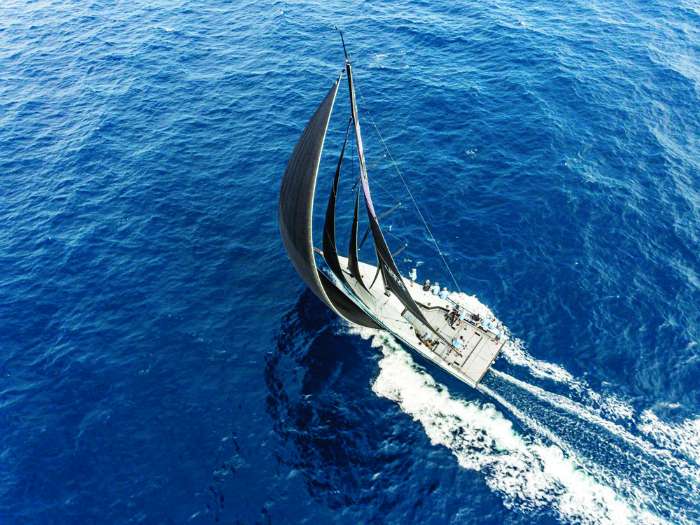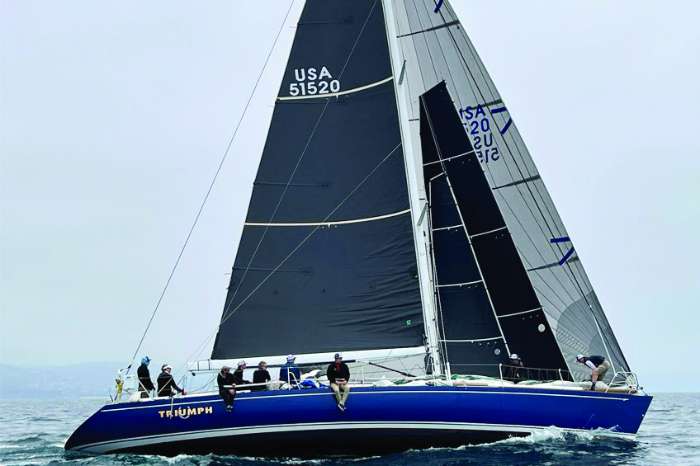The Staysail, an Important Weapon in Point-to-Point Sailboat Racing
As we swing into the distance-racing season, I thought it would be useful to talk about the staysail, little used in course racing, but an important weapon when going point to point. If you are lucky enough to do a true distance race such as the Trans-Atlantic or Trans-Pac, this is a sail (or sails) that you will probably have up a majority of the time. It has been a while, but the first time I did an Atlantic crossing we had our genoa staysail up for 11 of the 14 days. It was pretty much a constant.
While they come in all sizes and flavors, racing staysails are basically deployed inside reaching sails to augment horsepower and aid in balance. They can also help with generating flow between sails. Depending on size and shape, they can be used at tight angles as close as 60 degrees true wind angle (TWA)—as soon as the primary headsail is eased out—and aft to TWA’s as broad as 140 degrees.

Size and shape matter
The design range of a given staysail is determined by size (where it is tacked in the foretriangle) and shape (how full or flat the design is). An easy way to think of reaching staysails is that they come in three sizes: small, medium, and large. In Quantum terminology this translates into the Inner Genoa Staysail (IGS), an all-purpose or Squaretop Genoa Staysail (SGS), and an OGS or oversized genoa staysail.
The smallest or IGS is tacked at approximately 45 percent of the J (dimension between forward face of mast and where the headstay intersects the deck). It sheets very far inboard, usually to the same inboard tracks for the jib. It can be tacked to weather of the centerline, but usually it is on centerline. Small and flat, it can be sheeted hard and is almost capable of going upwind with the primary headsail. It comes into range as soon as sheets are eased or at about 60 degrees TWA. This is the staysail capable of being used at the closest angles.
As with all staysails you need a certain amount of apparent wind (usually 10 to 12 knots) to make it work. If you try to fly in too little apparent wind, it will just suck in the bigger sail you have up and close off the slot. The IGS sheets right up to the mainsail profile and actually helps flow across the bottom part of the mainsail.
The medium size staysail all purpose or SGS tacks at around 65 to 70 percent of J. It also sheets primarily to the inboard jib tracks but may have its lead moved outboard at broader angles. It is also tacked to the centerline with the option to move tack to weather at wider angles. Bigger and more powerful than the IGS, it is not quite as close winded. Typically, it becomes effective at TWA angles greater than 75 degrees. This sail is flown under reaching, high-clewed headsail (jib top or blast reacher) and under Code Zeros and A3 reaching spinnakers. It helps increase the range of the A0 and A3 reaching asymmetrical. The added horsepower lets you sail deeper angles effectively.

Both the IGS and SGS can be built as a square top (like a square top mainsail) with battens or as a furling sail with vertical battens. Full-length battens provide structure to optimize and preserve sail shape and allow for a reduced hoist while maintaining area and power. The square top configuration is generally considered more efficient from a shaping perspective. Furling sails, however, provide another level of ease of use. They can be set furled and left up until the angle and velocity are right and quickly deployed. Furling staysails are the choice for shorter races.
Hanked-on sails with battens are for true long distance. Sails with conventional battens are usually hanked on to a “carrier stay,” a light Dyneema stay not intended to handle load but merely to guide the sail up when hoisting and dropping so that it is not flailing and flogging. Both sails use a big torsional rope in the luff to handle the actual loads, and the boat must have a system for getting plenty of tension on the rope so that there is no sag.
The big (OGS) staysail goes further outboard, usually at around 80 to 85 percent of J. It is usually found on boats using sprits, so it has more room and will not interfere with the asymmetrical. The OGS is used at broader angles usually aft of 110 degrees TWA and can cross the gap to a full downwind A2 asymmetrical.
It's all about balance
It is also not uncommon to be able to use two or more staysails together if you are at the right angle and have enough velocity. This double or triple head rig is very cool looking and trendy. It also can work very well if the conditions are perfect. One of the other side benefits of using reaching staysails is balance. On a close reach or whenever you are at the closest angles a spinnaker can be carried, they help shift the center of effort forward and unload the helm. Oftentimes, in combination with a reef in the mainsail, they can help balance the helm and make the boat much easier to drive.
Staysails broaden the range of your sails in your crossover charts. For example, if you’re using a double staysail setup with a genoa-style boat, the staysails allow you to bring the range of the genoa down to a deeper angle so that you can avoid having to put your code zero up at too tight of an angle, preserving efficient flow. If you’re using the staysail with your code zero up, it causes the code zero angle to widen, allowing you to sail at a deeper angle, until you get into your soft sails. Working together, these sails help in the flow of the slot for more power and open up the angles of the other sails to reduce gaps in your crossover chart.
The bottom line is that reaching staysails have a number of advantages that make them worth the effort. Number one is that they can make the boat tenths of a knot faster. They also augment sail power, creating more slotting without excess sail area up high, which can close the slot on larger sails. They help break down the total sail area into smaller working components; and the shorter sails allow for more efficient slotting and minimize ventilating between headsails and code zeros or other reaching headsails.
For long distance races with lots of reaching there is no substitute! ~By David Flynn of Quantum Sails
Questions? Reach out to Quantum Sails.




